Accessibility of communications (Additional references)
How to make communications accessible
- Multiple formats
- Website accessibility
- Common accessibility symbols
- Improving communication with persons with disabilities
Standards for the accessibility of communications are set out in Removing Communication Barriers for Travellers with Disabilities (Communications Code).
Multiple formats
Canadian guidelines
- CNIB. Clear Print Design Standard.
- Clear Print is an accessible design standard for printed items ranging from magazines to computer screens.
International guidelines
- European Blind Union. Making information accessible for all
- American Printing House for the Blind. APH Guidelines for Print Document Design.
- World Wide Web Consortium (W3C). Web Content Accessibility Guidelines (WCAG) 2.0.
Starting with multiple formats
Making your original document more accessible will reduce the need for producing alternative formats. Content is only as accessible as the foundation it is built on.
Following the CNIB Clear Print guidelines - an accessible design standard for printed items ranging from magazines to computer screens – can help you produce more accessible content. The 10 variables explained in Clear Print can affect readers who have difficulty reading print – an increasingly large segment of today's market. Keep them in mind as you design your product.
Electronic formats (non-HTML)
ASCII text
ASCII (or plain) text for anything other than very short text blocks, is not considered an accessible format and should only be used as a last resort.
ePub
Accessible ePub 3 (2012, O'Reilly Associates) shows the power of ePub 3 for making content accessible to all users. The document is currently available for free.
The ePub 3 Standard is available through the International Digital Publishing Forum.
The following resources can assist in making accessible PDF files.
- PDF Techniques for WCAG 2.0
- Adobe Accessibility Centre
- WebAIM PDF Accessibility
- PDF Accessibility Checker (PAC)
DOC
Simple MS-Word files (e.g. those without graphics or tables) can be made accessible. However, if you have documents with images or tables, consider using an HTML format or PDF.
- Microsoft. Accessibility in MS-Office 2010.
- WebAIM. Microsoft Word accessibility techniques
Print formats
Braille
The Braille Literacy Canada's website contains the UEBC (Unified English Braille Code) Format Guidelines for producing Braille documents.
Large print documents
The necessity for producing large print documents is being supplanted by the increased use of electronic formats such as the web and e-readers such as iPad and Kindle. Modern e-readers and browsers provide rich accessibility options.
If large print documents are required, the following resources should be consulted for how to properly format these documents:
- Council of Citizens with Low Vision International. Best Practices and Guidelines for Large Print Documents used by the Low Vision Community.
- National Association for Visually Handicapped (NAVH). Standards and Criteria for Large Print Publications.
Audio formats
MP3
MP3 is a common consumer standard for digital audio and can be used to provide audio books.
Hardware and software for the recording and playback of MP3 audio are broadly available in the consumer marketplace.
DAISY Digital Talking Book
DAISY Digital Talking Book is a standard for digital audio books designed to be an audio substitute for print material. DAISY uses MP3 and XML or HTML5 as the basis for encoding content. The DAISY Consortium is currently aligning with ePub 3 as a single format for accessible multimedia content.
DAISY Consortium is responsible for maintaining the DAISY standard and has resources for creating and using DAISY files.
Video formats
- The Multimedia Accessibility FAQ is maintained by the W3C and provides many links and resources for making accessible videos.
- WCAG 2.0 provide guidelines, success criteria and techniques for the provision of Time-based Media (i.e. audio-only, video-only, audio-video, interactive audio-video).
- MAGpie (Media Access Generator) is a free caption- and audio-description authoring tool for making multimedia accessible to persons with sensory disabilities.
Other resources
- The Toronto Transit Commission (TTC) has produced a video on its website entitled "Easier Access Video" which provides information on planning a trip, taking a bus, using a subway, as well as other useful tips for the successful execution of a trip. The video is available in multiple formats, including a closed captioning version.
Generic multiple format policy
The following Multiple Format Policy has been developed in consultation with representatives of organizations of and for persons with disabilities as well as representatives of the transportation industry and includes key policy elements for trans portation service providers to include in their own policies.
- Personalized travel information is to be made available in multiple formats to passengers who request it. Multiple formats are to be available within a reasonable and consistent time frame. These time frames should be included in the Multiple Format Policy. Personalized travel information includes, but is not limited to: individual travel information including ticket information and information on terms and conditions of transport for the individual.
- Information available to the general public and documents of particular benefit to passengers with disabilities are to be readily available in multiple formats. The time frame for providing these documents in multiple formats should be no greater than that required for providing standard print versions. These include, but are not limited to: brochures describing services and equipment available to persons with disabilities, regulations for the carriage of passengers and luggage, terminal, aircraft, rail car and ferry vessel orientation material, information on ground transportation as outlined in section 2.5(b) of this Code, forms for the Canada Customs and Revenue Agency, lost luggage forms and information on terminal improvement fees.
- Personnel responsible for reservations or f or providing transportation - related information or documents to the public should have a list of documents that are readily available in multiple formats and those documents that will be produced on request. The length of advance notice required for the production of multiple formats of documents or customized extracts from these documents should also be included.
- If a document requested in a particular format is not available, personnel should be able to describe which alternatives or possible substitutes are available.
- Personnel are to honour requests for more than one format and/or more than one copy of any available format.
- Documents are to be produced in plain language that is clear and easy to understand, is respectful of persons with disabilities and uses appropriate terminology for persons with disabilities. Documents should avoid the use of acronyms, or clearly explain them.
- All formats are to be priced the same as printed materials. No additional cost should be incurred by passengers who require documents in multiple formats.
- Graphic material such as charts and graphs are to be converted into text - only format to make them compatible with text - to - voice systems and other formats. All passengers should be able to access the same information, regardless of the format they are using.
- All formats of documents are to be maintained to the same quality as print materials. Materials are to be proofread for quality, format and accuracy by someone who is capable of reviewing the format and should be updated at th e same time as original documents.
- The availability of multiple format versions is to be promoted on the cover of conventional print publications and promoted verbally when personnel make reference to publications. The availability of multiple formats is a lso to be noted in all promotional advertisements when print documents are referenced.
Website accessibility
World Wide Web Consortium (W3C) guidelines
- Web Accessibility Initiative (WAI)
- Web Content Accessibility Guidelines (WCAG) 2.0
The WCAG 2.0 guidelines are also an international ISO standard for accessibility, ISO/IEC 40500:2012. - WCAG 2.0 Conformance
Start with making your site compliant to at least WCAG 2.0 A level. However, for some kinds of transportation information, e.g. schedules, timetables, it may be necessary to use a higher level of compliance to ensure accessibility. - Techniques for WCAG 2.0
- Common Failures for WCAG 2.0
Web accessibility resources
- WebAIM is dedicated to web accessibility and has a comprehensive range of resources and tools for assisting web developers.
- JuicyStudio provides very useful coding advice and a number of quality assurance tools for checking code for accessibility issues.
- AccessIT (The National Center on Accessible Information Technology in Education) maintains a list of resources on video and multimedia, web-based information, software applications, and other accessibility topics.
Conducting website accessibility evaluations
The following resources can help prepare website accessibility evaluations:
- Accessibility Evaluation Resources (W3C WAI) is a collection of resources that provide a comprehensive overview of the process of accessibility evaluation, including evaluation methods and tools.
- Planning, Evaluation, Repair and Maintenance of Web Accessibility (WebAIM) is an overview of the requirements for an effective accessibility evaluation and repair strategy.
- Website Accessibility Conformance Evaluation Methodology (WCAG-EM) is an international effort to create a harmonized methodology for evaluating website WCAG 2.0 conformance.
Accessibility validation tools
- List of Web Accessibility Evaluation Tools is maintained by the W3C WAI team and contains a broad range of tools for validating or assessing sites as well as specific tools for checking characteristics such as color contrast, CSS, PDF, etc.
- W3C Markup Validation Service
- Ensure your site validates according to an HTML standard such as XHTML 1.0 or HTML5. This is the first step to ensure usability and accessibility for all users.
- WAVE – Web Accessibility Evaluation Tool
- This tool is available for Firefox and Dreamweaver and provides a simple means for identifying common accessibility problems on web pages.
- Web Accessibility Toolbar For IE, 2012
- This IE toolbar aids the manual examination of web pages for a variety of aspects of accessibility.
- Juicy Studio Accessibility Toolbar
- This Firefox toolbar enables developers to examine WAI-ARIA live regions roles and properties, examine data tables, and determine if the color contrast is sufficient.
- Vischeck
- Vischeck is a visual simulator that can show how a web page looks to someone with either of three types of color blindness.
- Contrast Checker
- This tool is for designers and developers to test color contrast compliance with the Web Content Accessibility Guidelines (WCAG) 2.0.
Common accessibility symbols
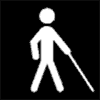 Accessible to people who are partially sighted |
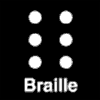 Braille |
 Information |
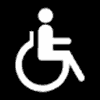 International symbol of access |
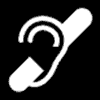 Services available for people with hearing impairments |
 Staff trained to help |
 Stairs |
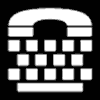 TTY |
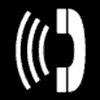 Volume control telephone |
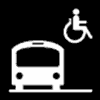 Wheelchair accessible bus |
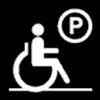 Wheelchair accessible parking |
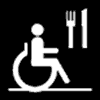 Wheelchair accessible restaurant |
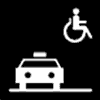 Wheelchair accessible taxi |
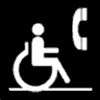 Wheelchair accessible telephone |
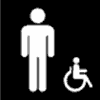 Wheelchair accessible washroom |
 Working dogs welcome |
Improving communication with persons with disabilities
General guidelines
- Personal communication is highly valued by persons with disabilities. Technology should never be considered a replacement for personal communication.
- The industry should continue to provide the personal communication services currently offered to travellers with disabilities, including "meet and greet" personnel or volunteers. Quality control mechanisms should be established to ensure that consistent and reliable service is provided to travellers with disabilities. Personnel should allow extra time to provide assistance to persons with disabilities.
- Promote self-identification. Many travellers with disabilities remain unaware of the benefits of expressing their particular disability-related needs to carriers prior to travel. Carriers should actively promote the services that are available to persons with disabilities and the benefits of self-identification.
- In all training programs, the importance of having a working knowledge of equipment, services and policies regarding travellers with disabilities, including those related to communication, should be stressed.
- Ideally, persons with disabilities should be involved in training sessions. This Resource tool and its appendices should also be used when providing personnel training on service to persons with disabilities.
- Computerized information kiosks are a very useful way for travellers to obtain information about terminal facilities and services. Many travellers however, prefer personal communication. Both should be considered in the design and administration of the terminal.
- Advance information about terminal facilities is very valuable and contributes significantly to decreasing the stress of travel and increasing the level of confidence and independence of travellers. Advance information could include information about the terminal layout and design, location of information service kiosks, along with other unique features of the terminal.
- When developing new technologies or facilities, or upgrading existing technologies or facilities, the principles of universal design should be used to ensure that products are usable by all people, to the greatest extent possible, without the need for specialized design.
- Establishing a barrier-free committee to oversee the implementation of the Code and other accessibility initiatives will help to ensure that facilities and services accommodate the accessibility needs of the broadest diversity of persons with disabilities. The involvement of persons with disabilities and representatives of organizations of and for persons with disabilities is critical when developing services or finding solutions to barriers to accessibility.
- Respect the stated needs of the passenger. Ask the person how you can help or how best to facilitate communication – each individual knows his or her own needs best. All personnel should accept the determination made by or on behalf of a person with a disability that the person does not require any extra services during a trip.
Persons who are deaf, deafened, hard of hearing or who have a speech impairment
- Be aware of the communication techniques used by persons who are Deaf, deafened, hard of hearing, or who have a speech impairment. Many people feel comfortable using pen and paper. Some also lip or speech read, use sign language, or use an assistive listening system (refer to end of this Appendix for more information).
- Sign Language is a distinct visual-gestural language used by persons who are Deaf, deafened, or hard of hearing. It differs from spoken languages in that it is visual rather than oral. It has its own structure, syntax and grammar. There are two predominate languages used in North America, American Sign Language (ASL) or Langue des signes québécoise (LSQ). Passengers from abroad may use other sign languages.
- Speech reading or lip reading requires watching the lips of a speaker and is used to complement the understanding of the spoken word. However, speech reading or lip reading does not always allow for recognition of all the letters of the alphabet. This is the case, more particularly the letters m, p, b, f, v, r, and q k.
- Be aware of and be able to contact any personnel who use sign language so they can be called upon, when necessary, to assist in communicating with passengers who communicate by sign language.
- Face the person to whom you are speaking. Speak clearly, normally, not too quickly and avoid exaggerated lip movement or raising your voice, unless asked to do so. Avoid covering your mouth, chewing gum or turning away, especially in the middle of a sentence.
- Repeat, rephrase or put information in writing when necessary.
- Be informed about the use of assistive devices and technical aids (such as TTYs) and about the use of telephone relay systems which allow communication between telephone and TTY users (refer to end of this Appendix for more information).
Persons who are blind or partially sighted
Communication with passengers often involves giving directions. As such, this section includes guidelines for directing passengers who are blind or who have vision impairments, who require a person to guide them and/or who use a guide dog to assist with wayfinding.
- Indicate your presence, introduce yourself and tell the person the reason for your presence. Ask if and how the person needs help.
- When distributing print information that is not in a format that can be read by the person, offer to read or summarize it.
- Be clear and precise when giving directions (e.g."two steps behind you", "a metre to your left", etc.).
- Offer to guide the person to where they are going.
- Offer your arm to the person or ask how you can best assist them. Walk at a normal pace. The person will usually walk about a step behind you. Do not grab the person or attempt to steer them.
- Announce handrails, doors (e.g. "to the right," "push to open," etc.), number of stairs up or down, etc. Pause at obstacles, such as stairs or curbs, to announce them to the passenger.
- When going up or down stairs, remain one stair ahead of the person.
- If the person wishes to sit, offer to guide the person and place his or her hand on the back of the chair. Never back a person who is blind or partially sighted into a chair. Inform the person of the kind of seating provided (e.g. bench seating near other passengers, swivel chair, wheelchair).
- Do not seat a person who is blind or partially sighted in a wheelchair without his or her permission and do not push or move the wheelchair without informing the person and asking permission.
- When assisting someone with a guide dog, do not disturb the dog. Never pet, feed, talk to or direct a guide dog wearing a harness. The dog is at work and needs to concentrate.
- Ask the person on which side you should be. As the dog will usually be at its owner's left side, many people will ask that you stand to the right a step or two behind. Offer the person your arm if extra guidance seems necessary.
- Ask before opening a door for a person who is blind or partially sighted, as the person may be using the door's location as a reference point, or may prefer to do it themself to protect the dog's paws.
Persons who are deaf-blind
- In most cases, the person who is deaf-blind will inform you, either through speech, an intervener or companion, in writing, or by way of preprinted "help card" messages of the preferred mode of communication.
- Most persons who are deaf-blind communicate using finger spelling, printing letters in the palm, or tactile sign language. Passengers who are deaf-blind may also use Braille or, if the person has some residual vision, large print.
- Ask frequently whether your communication is understood.
- Personnel should be aware of the universal sign for an emergency situation, i.e., drawing the letter X on the back of the person who is deaf-blind with the fingertips.
Persons who have a cognitive disability or a learning disability
- Keep sentences short and clear and simplify vocabulary as necessary.
- Verify that the message has been understood by asking the person to summarize the key points. Be prepared to repeat and rephrase.
- Ask the person if they would like key information provided in writing.
- Date modified:
